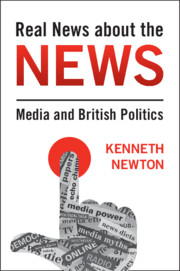96 results
4 - The New Gatekeepers?
- from Part I - Trusted Communicators
-
-
- Book:
- Media and Society After Technological Disruption
- Published online:
- 16 May 2024
- Print publication:
- 23 May 2024, pp 35-46
-
- Chapter
-
- You have access
- Open access
- HTML
- Export citation
19 - Structuring a Subsidy for Local Journalism
- from Part IV - Sustaining Journalistic Institutions
-
-
- Book:
- Media and Society After Technological Disruption
- Published online:
- 16 May 2024
- Print publication:
- 23 May 2024, pp 242-260
-
- Chapter
-
- You have access
- Open access
- HTML
- Export citation
18 - From Hot News to Link Tax
- from Part IV - Sustaining Journalistic Institutions
-
-
- Book:
- Media and Society After Technological Disruption
- Published online:
- 16 May 2024
- Print publication:
- 23 May 2024, pp 220-241
-
- Chapter
-
- You have access
- Open access
- HTML
- Export citation
4 - Newspaper Narratives in Occupied Ukraine
-
- Book:
- Propaganda and Ideology in the Russian–Ukrainian War
- Published online:
- 16 May 2024
- Print publication:
- 23 May 2024, pp 65-82
-
- Chapter
- Export citation
17 - How Local TV News Is Surviving Disruption as Newspapers Fail
- from Part IV - Sustaining Journalistic Institutions
-
-
- Book:
- Media and Society After Technological Disruption
- Published online:
- 16 May 2024
- Print publication:
- 23 May 2024, pp 198-219
-
- Chapter
-
- You have access
- Open access
- HTML
- Export citation
20 - Saving the News
- from Part IV - Sustaining Journalistic Institutions
-
-
- Book:
- Media and Society After Technological Disruption
- Published online:
- 16 May 2024
- Print publication:
- 23 May 2024, pp 261-280
-
- Chapter
-
- You have access
- Open access
- HTML
- Export citation
16 - Introduction
- from Part IV - Sustaining Journalistic Institutions
-
-
- Book:
- Media and Society After Technological Disruption
- Published online:
- 16 May 2024
- Print publication:
- 23 May 2024, pp 195-197
-
- Chapter
-
- You have access
- Open access
- HTML
- Export citation
5 - Sexuality and the Print Media in the Modern World
-
-
- Book:
- The Cambridge World History of Sexualities
- Published online:
- 26 April 2024
- Print publication:
- 16 May 2024, pp 94-113
-
- Chapter
- Export citation
Introduction
-
- Book:
- Applied Science
- Published online:
- 15 March 2024
- Print publication:
- 28 March 2024, pp 1-16
-
- Chapter
- Export citation
Chapter 10 - Empire and Evidence in Armadale and the Morant Bay Rebellion
-
-
- Book:
- Nineteenth-Century Literature in Transition: The 1860s
- Published online:
- 01 February 2024
- Print publication:
- 08 February 2024, pp 185-202
-
- Chapter
- Export citation

Real News about the News
- Media and British Politics
-
- Published online:
- 09 February 2024
- Print publication:
- 01 February 2024
17 - Subjective and Objective: Newspaper Columns
- from Part II - Voicing the American Experiment (1865–1945)
-
-
- Book:
- The Cambridge History of the American Essay
- Published online:
- 28 March 2024
- Print publication:
- 14 December 2023, pp 280-299
-
- Chapter
- Export citation
Chapter 2 - War and the Culture of Politeness
- from Part I - Developing Ideals
-
- Book:
- Imagining War and Peace in Eighteenth-Century Britain, 1690–1820
- Published online:
- 10 January 2024
- Print publication:
- 23 November 2023, pp 57-74
-
- Chapter
- Export citation
4 - Changing Cultures of Execution: Reason and Reforms, 1770–1808
-
- Book:
- Execution, State and Society in England, 1660–1900
- Published online:
- 12 October 2023
- Print publication:
- 26 October 2023, pp 94-140
-
- Chapter
- Export citation
1 - Introduction
-
- Book:
- Execution, State and Society in England, 1660–1900
- Published online:
- 12 October 2023
- Print publication:
- 26 October 2023, pp 1-29
-
- Chapter
- Export citation
The Internationalization of the Newspaper Industry 1989–2002: Three Scandinavian Cases
-
- Journal:
- Enterprise & Society / Volume 25 / Issue 2 / June 2024
- Published online by Cambridge University Press:
- 28 July 2023, pp. 592-626
- Print publication:
- June 2024
-
- Article
-
- You have access
- Open access
- HTML
- Export citation
19 - Japanese Mass Media
- from Part III - Social Practices and Cultures in Modern Japan
-
-
- Book:
- The New Cambridge History of Japan
- Published online:
- 19 May 2023
- Print publication:
- 08 June 2023, pp 645-670
-
- Chapter
- Export citation
Chapter 2 - The Short Story and the Early Magazine
- from Part I - Contexts
-
-
- Book:
- The Cambridge Companion to the American Short Story
- Published online:
- 11 May 2023
- Print publication:
- 25 May 2023, pp 31-45
-
- Chapter
- Export citation
Slivovitz and Everyday Nationalism: The Analysis of Slovene Newspapers in Interwar Yugoslavia
-
- Journal:
- Nationalities Papers / Volume 52 / Issue 3 / May 2024
- Published online by Cambridge University Press:
- 27 April 2023, pp. 685-700
- Print publication:
- May 2024
-
- Article
-
- You have access
- Open access
- HTML
- Export citation
3 - Memorials, Feelings, and Public Recognition, c. 1911–1915
-
- Book:
- Grief and the Shaping of Muslim Communities in North India, c. 1857–1940s
- Published online:
- 03 March 2023
- Print publication:
- 09 March 2023, pp 107-147
-
- Chapter
- Export citation



